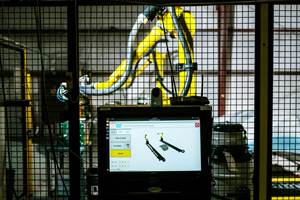Media Lodging
Ceramic media chips and small media are lodging in the parts during our vibratory process. How can we prevent or eliminate these problems?
Q. Ceramic media chips and small media are lodging in the parts during our vibratory process. How can we prevent or eliminate these problems? J.F.
A. Ceramic media chips and small media lodging are two separate problems. Your overall solution options include: 1. Selecting a non-chipping ceramic media; 2. Media classification (removal of chips and small media from the media mass).
Selecting a non-chipping ceramic media starts by identifying the main causes of chipping, which can include media shape, media formulation, and parts that are large and heavy.
Media shapes with sharp, protruding edges or points (angle-cut tri-stars, tri-angles and cylinders, left to right, below) are prone to chipping.
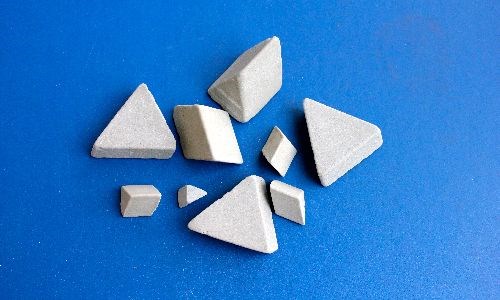
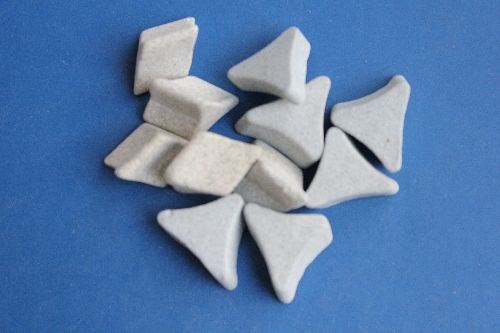
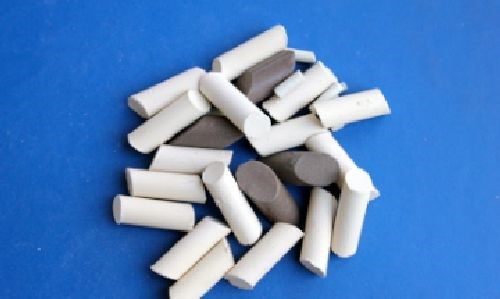
Examples of non-chipping ceramic media shapes are cylindrical wedges (left) and cones (right), neither of which have sharp, protruding edges.
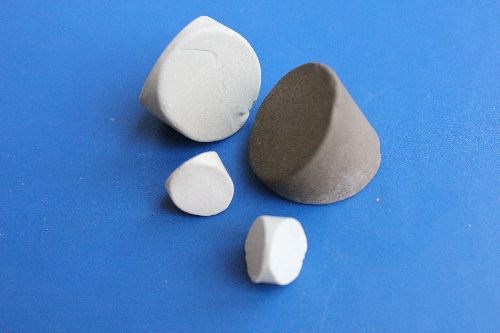

These media have flats that create long-edge contact time for excellent deburring. They also have spherical surfaces that create single-point part contact for concentrated impact areas, producing excellent surface finishes. Cylindrical wedges and cones roll well in all finishing machines and are available in sizes from 3/8 to 2 inches. When starting with all new media, various sizes will create a media mix that results in reduced chipping.
Media formulation is as critical as media shape for eliminating ceramic media chipping. The harder-polishing and medium-cut ceramic media formulations chip more than the softer-bonding formulations of the faster-cutting media. The best recommendation for non-chipping ceramic media is the high-density (HD) formulation. The HD tough bond is created by higher kiln temperature and cure times during manufacturing. HD media, which is available in all ceramic shapes and sizes, is the heaviest ceramic produced, with weights as heavy as 120 to 140 lbs/cu ft compared with 80 lbs/cu ft for regular ceramic media.
Large, heavy parts crush and chip ceramic media. The media gets caught between the part and the machine’s sidewall as the part rotates, creating media chipping and part damage. These parts have to be fixtured within the finishing systems to eliminate chipping. A soft synthetic plastic media will eliminate part damage on non-fixtured, large, heavy parts, but will also chip.
Small-media lodging problems are created by the ceramic media wearing down. All cutting and deburring media wear from their original size to virtually nothing. The pre-formed media do retain their shapes as they wear, but get smaller and smaller. This type of wear makes small-media lodging problems predictable, but the media can be removed by media classification systems.
Media classification systems will remove media chips and small media from the media mass. This should be built into the machine and provide continuous media classification while the machine is running. Media classification can be done outside of the machine, but without continuous classification, the small-media size problem will quickly reoccur.
Two examples of built-in media classification systems are a slotted-drain system and a slotted media-unload plug. The slots in either system should be 1/16-inch larger than the small media that need to be removed. Media chips also will be removed because they generally are even smaller.
Bowl vibratory machines and continuous in-line tubs are recommended when continuous classification within the machine is required. The media action in the bowl and tubs sweeps the media continuously by the slotted classification systems, enabling small media and chips to be removed. Media classification with standard tub vibrators, high-energy centrifugal discs and centrifugal barrel machines is done external to the machines.
Related Content
Hubbard-Hall Technical Team Adds Senior Chemist to Staff
David Keller is joining the Hubbard-Hall technical team as a senior chemist.
Read MoreRobot-Ready Grinding Systems for High-Speed Production
Advanced rotary surface grinders now come “robot-ready” to facilitate integration with third party robotic arms and fully automate the process from loading to unloading.
Read MoreBlast Nozzle Features Enhanced Noise Reduction
Kennametal adds noise-reducing Blast Ninja to portfolio of abrasive blast nozzles.
Read MoreAI-Powered Robotic Solutions Support High-Mix Finishing
AI startup offers automation innovations for high-mix, high-variability, manual surface finishing applications.
Read MoreRead Next
Education Bringing Cleaning to Machining
Debuting new speakers and cleaning technology content during this half-day workshop co-located with IMTS 2024.
Read MoreEpisode 45: An Interview with Chandler Mancuso, MacDermid Envio Solutions
Chandler Mancuso, technical director with MacDermid Envio discusses updating your wastewater treatment system and implementing materials recycling solutions to increase efficiencies, control costs and reduce environmental impact.
Read MoreDelivering Increased Benefits to Greenhouse Films
Baystar's Borstar technology is helping customers deliver better, more reliable production methods to greenhouse agriculture.
Read More














.jpg;maxWidth=300;quality=90)






